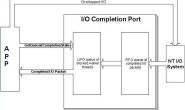INI文件简介
在我们写程序时,总有一些配置信息需要保存下来,以便在下一次启动程序完成初始化,这实际上是一种类持久化。将一些信息写入INI文件(initialization file)中,可完成简单的持久化支持。
Windows提供了API接口用于操作INI文件,其支持的INI文件格式一般如下:
===============================
[Section1]
Key11=value11
Key12=value12
[Section2]
Key21=value21
Key22=value22
…
[SectionN]
KeyN1=valueN1
KeyN2=valueN2
===============================
一般一个INI文件可有N个节,每节可有n个键名及值对应,每个键名及其值以等式形式占一行。
一般键的名称可任取,不过建议用有意义的字符及词构成。值一般可为整数和字符串,其它类型要进行转换。
常见的系统配置文件:
C:/boot.ini
C:/WINDOWS/win.ini
C:/WINDOWS/system.ini
C:/WINDOWS/desktop.ini
C:/WINDOWS/Resources/Themes/Windows Classic.theme
注意,字符串存贮在INI文件中时没有引号;key和value之间的等号前后不容空格;注释以分号“;”开头。
VC中操作INI文件的API
(1)操作系统配置文件Win.ini的函数:
函数名 | 功能 |
GetProfileSection | 读取win.ini中指定节lpAppName中所有键名及其值。lpReturnedString字符串形式如下: Key1=Value1/0Key2=Value2/0…KeyN=ValueN/0/0 |
GetProfileString | 读取win.ini中指定节lpAppName中键名为lpKeyName对应变量的字符串值。 |
GetProfileInt | 读取win.ini中指定节lpAppName中键名为lpKeyName对应变量的整数值。 |
|
|
WriteProfileSection | 写(替换)win.ini中指定节lpAppName中的键值。 lpString字符串形式同GetProfileSection中的lpReturnedString。 |
WriteProfileString | 写(替换)win.ini中指定节lpAppName中键名为lpKeyName对应变量的字符串值。 |
(2)操作用户自定义配置文件(PrivateProfile.ini)的函数:
函数名 | 功能 |
GetPrivateProfileSectionNames | 读取lpFileName指定的配置文件中所有的节名。lpszReturnBuffer字符串形式如下: Section1/0Section2/0…SectionN/0/0 |
GetPrivateProfileSection | 同GetProfileSection。 |
GetPrivateProfileString | 同GetProfileString。 |
GetPrivateProfileInt | 同GetProfileInt |
GetPrivateProfileStruct | 须同WritePrivateProfileStruct配套使用。 |
|
|
WritePrivateProfileSection | 同WriteProfileSection |
WritePrivateProfileString | 同WriteProfileString |
WritePrivateProfileStruct | 不常用。 |
注意:
(1)使用得最频繁的是 GetPrivateProfileString 和 WritePrivateProfileString,没有WriteProfileInt/WritePrivateProfileInt函数。
(2)Get系列读取节键值,如果文件路径有误或节键名不对则返回设定的默认值。
(3)访存自定义配置文件时,文件路径lpFileName必须完整,文件名前面的各级目录必须存在。如果lpFileName文件路径不存在,则函数返回FALSE,GetLastError() = ERROR_PATH_NOT_FOUND。如果路径正确,但是文件不存在,则该函数将先创建该文件。如果路径及文件存在,则在现有ini文件基础上进行读写。
如果 lpFileName 只指定文件名而没有路径的话,调用API将会去 Windows 的安装目录去查找而不会在当前目录查找。
(4)要对调用API的模块(exe)所在目录下进行配置文件操作,可使用形如“.//config.ini”的相对路径,注意转义符。
(5)调用WritePrivateProfileSection,若参数三 lpString为NULL,则可将对应section的全部内容清空;调用WritePrivateProfileString,若参数三 lpString为NULL,则可将对应key删除。
跨平台配置文件
INI文件本质是对文件和字符串的处理,因此在跨平台项目中的配置文件可以基于<stdio.h>中的标C文件FILE,然后实现像类似以上对节([Section])、键(Key)和值(Value)的字符串读写功能。
鉴于XML的树形描述层次结构性清晰,现在很多软件都大面积使用XML文件进行配置,如QQ的全局配置文件C:/Program Files/Tencent/QQ/gf-config.xml。java程序的配置文件基本都使用XML格式,C++中并没有操作XML文件的标准库。
在C/C++程序中要使用XML做为配置文件,涉及到XML的解析。Windows平台可使用MsXml对XML进行解析,参考《MsXml创建和解析XML示例》,跨平台可以考虑自己实现,或使用C++ BOOST正则表达式,或选择Free C or C++ XML Parser Libraries,如XmlParser、TinyXML、CMarkup、libxml等。
CIniFile类
以下提供对Windows操作INI文件的API的简单封装类CIniFile。
// IniFile.h #ifndef __INIFILE_H__ #define __INIFILE_H__ class CIniFile { public: CIniFile(); CIniFile(LPCTSTR szFileName); virtual ~CIniFile(); public: // Attributes void SetFileName(LPCTSTR szFileName); public: // Operations BOOL SetProfileInt(LPCTSTR lpszSectionName, LPCTSTR lpszKeyName, int nKeyValue); BOOL SetProfileString(LPCTSTR lpszSectionName, LPCTSTR lpszKeyName, LPCTSTR lpszKeyValue); DWORD GetProfileSectionNames(CStringArray& strArray); // 返回section数量 int GetProfileInt(LPCTSTR lpszSectionName, LPCTSTR lpszKeyName); DWORD GetProfileString(LPCTSTR lpszSectionName, LPCTSTR lpszKeyName, CString& szKeyValue); BOOL DeleteSection(LPCTSTR lpszSectionName); BOOL DeleteKey(LPCTSTR lpszSectionName, LPCTSTR lpszKeyName); private: CString m_szFileName; // .//Config.ini, 如果该文件不存在,则exe第一次试图Write时将创建该文件 UINT m_unMaxSection; // 最多支持的section数(256) UINT m_unSectionNameMaxSize; // section名称长度,这里设为32(Null-terminated) void Init(); }; #endif // IniFile.cpp #include “IniFile.h” void CIniFile::Init() { m_unMaxSection = 512; m_unSectionNameMaxSize = 33; // 32位UID串 } CIniFile::CIniFile() { Init(); } CIniFile::CIniFile(LPCTSTR szFileName) { // (1) 绝对路径,需检验路径是否存在 // (2) 以”./”开头,则需检验后续路径是否存在 // (3) 以”../”开头,则涉及相对路径的解析 Init(); // 相对路径 m_szFileName.Format(“.//%s”, szFileName); } CIniFile::~CIniFile() { } void CIniFile::SetFileName(LPCTSTR szFileName) { m_szFileName.Format(“.//%s”, szFileName); } DWORD CIniFile::GetProfileSectionNames(CStringArray &strArray) { int nAllSectionNamesMaxSize = m_unMaxSection*m_unSectionNameMaxSize+1; char *pszSectionNames = new char[nAllSectionNamesMaxSize]; DWORD dwCopied = 0; dwCopied = ::GetPrivateProfileSectionNames(pszSectionNames, nAllSectionNamesMaxSize, m_szFileName); strArray.RemoveAll(); char *pSection = pszSectionNames; do { CString szSection(pSection); if (szSection.GetLength() < 1) { delete[] pszSectionNames; return dwCopied; } strArray.Add(szSection); pSection = pSection + szSection.GetLength() + 1; // next section name } while (pSection && pSection<pszSectionNames+nAllSectionNamesMaxSize); delete[] pszSectionNames; return dwCopied; } DWORD CIniFile::GetProfileString(LPCTSTR lpszSectionName, LPCTSTR lpszKeyName, CString& szKeyValue) { DWORD dwCopied = 0; dwCopied = ::GetPrivateProfileString(lpszSectionName, lpszKeyName, “”, szKeyValue.GetBuffer(MAX_PATH), MAX_PATH, m_szFileName); szKeyValue.ReleaseBuffer(); return dwCopied; } int CIniFile::GetProfileInt(LPCTSTR lpszSectionName, LPCTSTR lpszKeyName) { int nKeyValue = ::GetPrivateProfileInt(lpszSectionName, lpszKeyName, 0, m_szFileName); return nKeyValue; } BOOL CIniFile::SetProfileString(LPCTSTR lpszSectionName, LPCTSTR lpszKeyName, LPCTSTR lpszKeyValue) { return ::WritePrivateProfileString(lpszSectionName, lpszKeyName, lpszKeyValue, m_szFileName); } BOOL CIniFile::SetProfileInt(LPCTSTR lpszSectionName, LPCTSTR lpszKeyName, int nKeyValue) { CString szKeyValue; szKeyValue.Format(“%d”, nKeyValue); return ::WritePrivateProfileString(lpszSectionName, lpszKeyName, szKeyValue, m_szFileName); } BOOL CIniFile::DeleteSection(LPCTSTR lpszSectionName) { return ::WritePrivateProfileSection(lpszSectionName, NULL, m_szFileName); } BOOL CIniFile::DeleteKey(LPCTSTR lpszSectionName, LPCTSTR lpszKeyName) { return ::WritePrivateProfileString(lpszSectionName, lpszKeyName, NULL, m_szFileName); }
参考:
《INI操作类》
《INI文件查看器》




